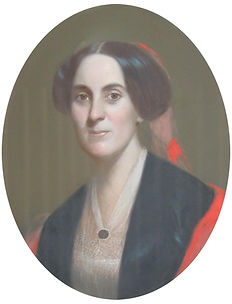The Black Family at Woodlawn


After the American Revolutionary war, William Bingham, a wealthy Philadelphian, purchased two million acres of land in Maine, known as the Bingham lands. He hired General David Cobb, of Taunton
Massachusetts, to be the land agent for his purchase. William Bingham then sold a half interest in his land to the Baring Brothers Bank of London. In 1798, the bank sent a young clerk, 18-year-old John Black, to help oversee their share of the land and to serve as the bank's representative.
In 1802, John married David Cobb’s daughter Mary and they had eight children. With income from land sales and a generous annual salary, John Black began to venture into the lumber, shipping, and mercantile businesses that quickly provided him with great wealth and status. In 1824, when John Black was 44 years old, he initiated construction of the Black House at Woodlawn. The house includes a wing that John used as his office to run his businesses, five bedrooms, and seven chimneys. The family moved into the house on November 7, 1827. An Ell was attached for the kitchen, preparations, and wood shed.
From the house, situated on a hill with sweeping views of the Union River, John Black could sit on his deck and see his sailing schooners being loaded with lumber for shipment to Boston and returning schooners bringing merchandise to the family’s store in Ellsworth. The property was a homestead for the family and hired help. The whole property included forested lands as well as fields for grazing, a pond, a large barn for horses, cows, chickens, hay, and carriages, a family tomb, and the iconic brick mansion house.

Mary passed away in 1851. After Mary’s death, John married Frances Hodges Wood in 1852. John passed away only four years later in 1856. Upon his death, Frances was given a life tenancy at the Woodlawn estate. She made many changes to the Black House such as adding gas lighting and a coal furnace. Frances was the last of the Black Family to live at Woodlawn year-round. She died in 1874 at the age of 70 and the Woodlawn estate transferred to George Nixon Black Sr., John and Mary’s fourth son.


Growing up in Ellsworth, George worked with his father in the family Black & Sons business. He married Mary Peters in 1836, who was from a prominent local family. They had four children and lived in a house still beside the Ellsworth Post Office. As his father’s eyesight failed, George took over the family business which grew and expanded to Boston. He moved his family there in 1859. He and his family regularly visited Woodlawn during business trips to Ellsworth and supported Frances while she lived here. They would stay at Woodlawn while visiting extended family. After Frances passed, George, an avid horseman began reviving Woodlawn as a farm. George died in 1880 and Mary continued visiting Ellsworth every summer with her children until her death in 1902.

The only son of George and Mary, George 'Nixon' Black Jr. inherited Woodlawn after his fathers’ death. He never married and his three sisters died before him, all quite young. He loved animals and the arts. He continued to keep and enjoy horses at Woodlawn as well as dogs. He never lived at the property full time but was known to visit each summer with his mother, cousins, and friends.
Nixon who died in 1928 arranged for the future of Woodlawn in his will, gifting it to the Hancock County Trustees of Public Reservations, with instructions that the grounds remain open for public enjoyment and the house to open as a museum which it did in 1929.



